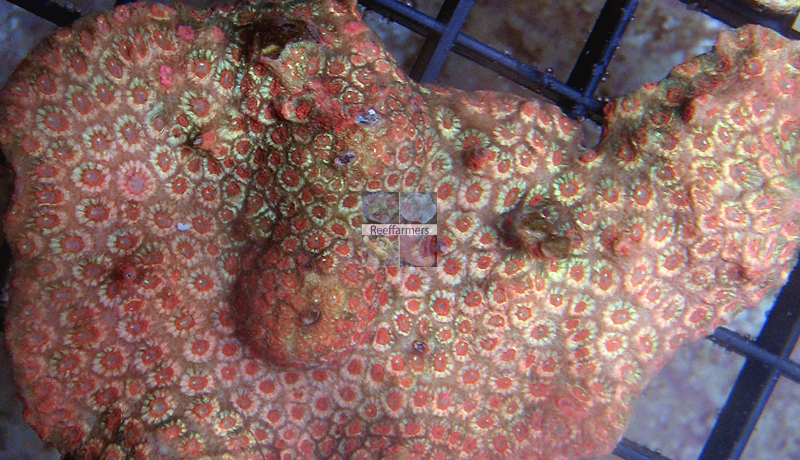Plesiastrea versipora is a very unique and unique-looking coral which is widespread in the Indo-Pacific Ocean. There is only one other species in the genus Plesiastrea, P. devantieri but like Acanthastrea maxima, that species only comes from the Red Sea and surrounding waters. Plesiastrea has small corallites for a Faviid, just a wee bit bigger than most Cyphastrea species and it usually grows flat or semi lobed. The few colonies of Plesiastreawe we have come across all exhibited interesting and sometimes amazing coloration, unique among moon brains, and this colony of yellow and red Plesiastrea versipora is no exception.

Unless you’re looking for it, a Plesiastrea coral will most often be misidentified as a Cyphastrea, as Mr. Limited Edition Coral himself has done with the incredible Plesiastrea versipora above that he calls the ‘Inferno Cyphastrea‘. The yellow and red Plesiastrea colony was imported by Oculus Aquatics where staff assigned this colony for propagation. Even without knowing exactly what it is,the Inferno Plesiastrea is clearly not your average small polyped moon coral.
Compare the Plesiastrea to two other coral strains which have been grown in captivity for a little while, the PPE Chalice and Copperhead Cyphastrea. The PPE Chalice is believed to be a Plesiastrea since the original colony had a flat shape with semi-crowded corallites and a very unusual color pallette. Grown out frags of the PPE Chalice take on an even more un-Cyphastrea like appearance.

By contrast, World Wide Corals’ Copperhead Cyphastrea shares a similar color with Reef Farmers’ Inferno, but it has much more exert and conically shaped corallites, as would be expected of a good card-carrying specimen of the much more common genus of Faviids.
Nothing makes us roll our eyes more than seeing a fairly common, abundant and unremarkable coral get earmarked for ‘Limited Edition’ stature (see the Porites parody here). However in the case of the Inferno, we really have a thing for the seldom-seen Plesiastrea versipora as a coral and a species – this actually may be a case where the coral collectors may have under-appreciated what kind of stony coral they have on their hands.




